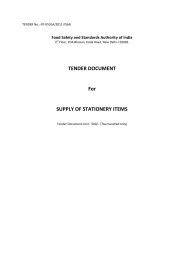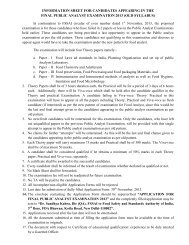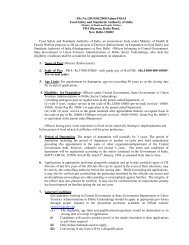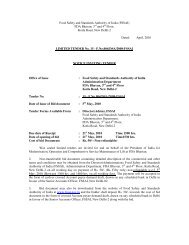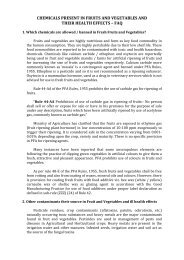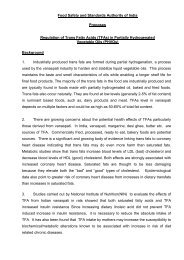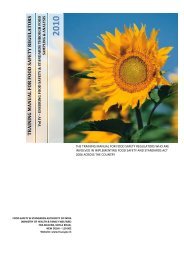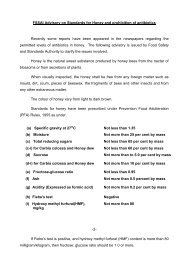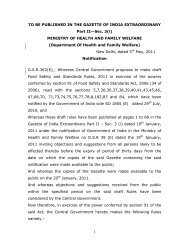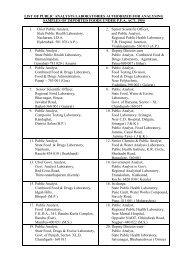codex general standard for contaminants and toxins in food and feed
codex general standard for contaminants and toxins in food and feed
codex general standard for contaminants and toxins in food and feed
Create successful ePaper yourself
Turn your PDF publications into a flip-book with our unique Google optimized e-Paper software.
1 Codex St<strong>and</strong>ard 193-1995CODEX GENERAL STANDARD FOR CONTAMINANTS AND TOXINSIN FOOD AND FEED1. PREAMBLECODEX STAN 193-19951.1 SCOPEThis St<strong>and</strong>ard conta<strong>in</strong>s the ma<strong>in</strong> pr<strong>in</strong>ciples which are recommended by the Codex Alimentarius <strong>in</strong> deal<strong>in</strong>g with<strong>contam<strong>in</strong>ants</strong> <strong>and</strong> <strong>tox<strong>in</strong>s</strong> <strong>in</strong> <strong>food</strong> <strong>and</strong> <strong>feed</strong>, <strong>and</strong> lists the maximum levels <strong>and</strong> associated sampl<strong>in</strong>g plans of <strong>contam<strong>in</strong>ants</strong><strong>and</strong> natural toxicants <strong>in</strong> <strong>food</strong> <strong>and</strong> <strong>feed</strong> which are recommended by the CAC to be applied to commodities mov<strong>in</strong>g <strong>in</strong><strong>in</strong>ternational trade.This St<strong>and</strong>ard <strong>in</strong>cludes only maximum levels of <strong>contam<strong>in</strong>ants</strong> <strong>and</strong> natural toxicants <strong>in</strong> <strong>feed</strong> <strong>in</strong> cases where thecontam<strong>in</strong>ant <strong>in</strong> <strong>feed</strong> can be transferred to <strong>food</strong> of animal orig<strong>in</strong> <strong>and</strong> can be relevant <strong>for</strong> public health.1.2 DEFINITION OF TERMS1.2.1 GeneralThe def<strong>in</strong>itions <strong>for</strong> the purpose of the Codex Alimentarius, as mentioned <strong>in</strong> the Procedural Manual, are applicable to theGeneral St<strong>and</strong>ard <strong>for</strong> Contam<strong>in</strong>ants <strong>and</strong> Tox<strong>in</strong>s <strong>in</strong> Food <strong>and</strong> Feed (GSCTFF) <strong>and</strong> only the most important ones arerepeated here. Some new def<strong>in</strong>itions are <strong>in</strong>troduced, where this seems warranted to obta<strong>in</strong> optimal clarity. Whenreference is made to <strong>food</strong>s, this also applies to animal <strong>feed</strong>, <strong>in</strong> those cases where this is appropriate.1.2.2 Contam<strong>in</strong>antCodex Alimentarius def<strong>in</strong>es a contam<strong>in</strong>ant as follows:“Any substance not <strong>in</strong>tentionally added to <strong>food</strong>, which is present <strong>in</strong> such <strong>food</strong> as a result of the production (<strong>in</strong>clud<strong>in</strong>goperations carried out <strong>in</strong> crop husb<strong>and</strong>ry, animal husb<strong>and</strong>ry <strong>and</strong> veter<strong>in</strong>ary medic<strong>in</strong>e), manufacture, process<strong>in</strong>g,preparation, treatment, pack<strong>in</strong>g, packag<strong>in</strong>g, transport or hold<strong>in</strong>g of such <strong>food</strong> or as a result of environmentalcontam<strong>in</strong>ation. The term does not <strong>in</strong>clude <strong>in</strong>sect fragments, rodent hairs <strong>and</strong> other extraneous matter”.This <strong>st<strong>and</strong>ard</strong> applies to any substance that meets the terms of the Codex def<strong>in</strong>ition <strong>for</strong> a contam<strong>in</strong>ant, <strong>in</strong>clud<strong>in</strong>g<strong>contam<strong>in</strong>ants</strong> <strong>in</strong> <strong>feed</strong> <strong>for</strong> <strong>food</strong>-produc<strong>in</strong>g animals, except:1) Contam<strong>in</strong>ants hav<strong>in</strong>g only <strong>food</strong> <strong>and</strong> <strong>feed</strong> quality significance (e.g. copper), but no public healthsignificance, <strong>in</strong> the <strong>food</strong>(s) given that the <strong>st<strong>and</strong>ard</strong>s elaborated with<strong>in</strong> the Codex Committee onContam<strong>in</strong>ants <strong>in</strong> Foods (CCCF) has the objective to protect public health.2) Pesticide residues, as def<strong>in</strong>ed by the Codex def<strong>in</strong>ition that are with<strong>in</strong> the terms of reference of the CodexCommittee on Pesticide Residues (CCPR).3) Residues of veter<strong>in</strong>ary drugs, as def<strong>in</strong>ed by the Codex def<strong>in</strong>ition, that are with<strong>in</strong> the terms of reference ofthe Codex Committee on Residues of Veter<strong>in</strong>ary Drugs <strong>in</strong> Foods (CCRVDF).4) Microbial <strong>tox<strong>in</strong>s</strong>, such as botul<strong>in</strong>um tox<strong>in</strong> <strong>and</strong> staphylococcus enterotox<strong>in</strong>, <strong>and</strong> microorganisms that arewith<strong>in</strong> the terms of reference of the Codex Committee on Food Hygiene (CCFH).5) Residues of process<strong>in</strong>g aids that are with<strong>in</strong> the terms of reference of the Codex Committee on FoodAdditives (CCFA) 1 .1.2.3 Natural <strong>tox<strong>in</strong>s</strong> <strong>in</strong>cluded <strong>in</strong> this <strong>st<strong>and</strong>ard</strong>The Codex def<strong>in</strong>ition of a contam<strong>in</strong>ant implicitly <strong>in</strong>cludes naturally occurr<strong>in</strong>g toxicants <strong>in</strong>clud<strong>in</strong>g toxic metabolites ofcerta<strong>in</strong> microfungi that are not <strong>in</strong>tentionally added to <strong>food</strong> <strong>and</strong> <strong>feed</strong> (myco<strong>tox<strong>in</strong>s</strong>).Tox<strong>in</strong>s that are produced by algae <strong>and</strong> that may be accumulated <strong>in</strong> edible aquatic organisms such as shellfish(phyco<strong>tox<strong>in</strong>s</strong>) are also <strong>in</strong>cluded <strong>in</strong> this <strong>st<strong>and</strong>ard</strong>. Myco<strong>tox<strong>in</strong>s</strong> <strong>and</strong> phyco<strong>tox<strong>in</strong>s</strong> are both subclasses of <strong>contam<strong>in</strong>ants</strong>.Endogenous natural toxicants, such as e.g. solan<strong>in</strong>e <strong>in</strong> potatoes, that are implicit constituents of <strong>food</strong> <strong>and</strong> <strong>feed</strong> result<strong>in</strong>gfrom a genus, species or stra<strong>in</strong> ord<strong>in</strong>arily produc<strong>in</strong>g hazardous levels of a toxic metabolite(s), i.e. phyto<strong>tox<strong>in</strong>s</strong> are not<strong>general</strong>ly considered with<strong>in</strong> the scope of this <strong>st<strong>and</strong>ard</strong>. They are, however, with<strong>in</strong> the terms of reference of the CCCF<strong>and</strong> will be dealt with on a case by case basis.1Process<strong>in</strong>g aids are any substance or material, not <strong>in</strong>clud<strong>in</strong>g apparatus or utensils, <strong>and</strong> not consumed as a <strong>food</strong> <strong>in</strong>gredient by itself, <strong>in</strong>tentionallyused <strong>in</strong> the process<strong>in</strong>g of raw materials, <strong>food</strong>s or its <strong>in</strong>gredients, to fulfil a certa<strong>in</strong> technological purpose dur<strong>in</strong>g treatment or process<strong>in</strong>g <strong>and</strong> whichmay result <strong>in</strong> the non-<strong>in</strong>tentional but unavoidable presence of residues or derivatives <strong>in</strong> the f<strong>in</strong>al product.Adopted 1995. Revised 1997, 2006, 2008, 2009. Amended 2010.
2 Codex St<strong>and</strong>ard 193-19951.2.4 Maximum level <strong>and</strong> related terms 2The Codex maximum level (ML) <strong>for</strong> a contam<strong>in</strong>ant <strong>in</strong> a <strong>food</strong> or <strong>feed</strong> commodity is the maximum concentration of thatsubstance recommended by the Codex Alimentarius Commission (CAC) to be legally permitted <strong>in</strong> that commodity.1.3 PRINCIPLES REGARDING CONTAMINANTS IN FOOD AND FEED1.3.1 GeneralContam<strong>in</strong>ation of <strong>food</strong> <strong>and</strong> <strong>feed</strong> may pose a risk to human (<strong>and</strong>/or animal health). Moreover <strong>in</strong> some cases they mayalso have a negative impact on the quality of the <strong>food</strong> or <strong>feed</strong>. Food <strong>and</strong> <strong>feed</strong> can become contam<strong>in</strong>ated by variouscauses <strong>and</strong> processes.Contam<strong>in</strong>ant levels <strong>in</strong> <strong>food</strong> <strong>and</strong> <strong>feed</strong> shall be as low as reasonably achievable through best practice such as GoodAgricultural Practice (GAP) <strong>and</strong> Good Manufactur<strong>in</strong>g Practice (GMP) follow<strong>in</strong>g an appropriate risk assessment. Thefollow<strong>in</strong>g actions may serve to prevent or to reduce contam<strong>in</strong>ation of <strong>feed</strong> <strong>and</strong> <strong>food</strong> 3 :- prevent<strong>in</strong>g <strong>food</strong> <strong>and</strong> <strong>feed</strong> contam<strong>in</strong>ation at the source, e.g. by reduc<strong>in</strong>g environmental pollution.- apply<strong>in</strong>g appropriate technology control measure(s) <strong>in</strong> <strong>food</strong> <strong>and</strong> <strong>feed</strong> production, manufacture,process<strong>in</strong>g, preparation, treatment, pack<strong>in</strong>g, packag<strong>in</strong>g, transport or hold<strong>in</strong>g.- apply<strong>in</strong>g measures aimed at decontam<strong>in</strong>ation of contam<strong>in</strong>ated <strong>feed</strong> or <strong>food</strong> <strong>and</strong> measures to preventcontam<strong>in</strong>ated <strong>feed</strong> or <strong>food</strong> to be marketed <strong>for</strong> consumption.To ensure that adequate action is taken to reduce contam<strong>in</strong>ation of <strong>food</strong> <strong>and</strong> <strong>feed</strong> a Code of Practice shall be elaboratedcompris<strong>in</strong>g source related measures <strong>and</strong> Good Manufactur<strong>in</strong>g Practice as well as Good Agricultural Practice <strong>in</strong> relationto the specific contam<strong>in</strong>ation problem.The degree of contam<strong>in</strong>ation of <strong>food</strong> <strong>and</strong> <strong>feed</strong> <strong>and</strong> the effect of actions to reduce contam<strong>in</strong>ation shall be assessed bymonitor<strong>in</strong>g, survey programs <strong>and</strong> more specialized research programs, where necessary.When there are <strong>in</strong>dications that health hazards may be <strong>in</strong>volved with consumption of <strong>food</strong> that is contam<strong>in</strong>ated, it isnecessary that a risk assessment should be undertaken. When health concerns can be substantiated, a riskmanagement measure must be applied, based on a thorough evaluation of the situation <strong>and</strong> consideration of a range ofrisk management options. Depend<strong>in</strong>g on the assessment of the problems <strong>and</strong> the possible solutions, it may benecessary to establish MLs or other measures to control the contam<strong>in</strong>ation of <strong>food</strong> <strong>and</strong> <strong>feed</strong>. In special cases, specificadvice on dietary recommendations may also have to be considered to complement other regulatory measures, whenthe measures are not sufficiently adequate to protect public health <strong>and</strong> safety.National measures regard<strong>in</strong>g <strong>food</strong> <strong>and</strong> <strong>feed</strong> contam<strong>in</strong>ation should avoid the creation of unnecessary barriers to<strong>in</strong>ternational trade <strong>in</strong> <strong>food</strong> <strong>and</strong> <strong>feed</strong> commodities. The purpose of the GSCTFF is to provide guidance about possibleapproaches to elim<strong>in</strong>ate or reduce the contam<strong>in</strong>ation problem <strong>and</strong> to promote <strong>in</strong>ternational harmonization throughrecommendations which <strong>in</strong> turn may prevent trade barriers <strong>and</strong> disputes.For all <strong>contam<strong>in</strong>ants</strong>, which may be present <strong>in</strong> more than one <strong>feed</strong> or <strong>food</strong> item, a broad approach shall be applied,tak<strong>in</strong>g <strong>in</strong>to account all relevant <strong>in</strong><strong>for</strong>mation that is available, <strong>for</strong> the assess<strong>in</strong>g of risks <strong>and</strong> <strong>for</strong> develop<strong>in</strong>grecommendations <strong>and</strong> control measures, <strong>in</strong>clud<strong>in</strong>g the sett<strong>in</strong>g of maximum levels.1.3.2 Pr<strong>in</strong>ciples <strong>for</strong> establish<strong>in</strong>g maximum levels <strong>in</strong> <strong>food</strong> <strong>and</strong> <strong>feed</strong>MLs shall only be set <strong>for</strong> <strong>food</strong> <strong>in</strong> which the contam<strong>in</strong>ant may be found <strong>in</strong> amounts that are significant <strong>for</strong> the totalexposure of the consumer, tak<strong>in</strong>g <strong>in</strong>to consideration the Policy of the Codex Committee on Contam<strong>in</strong>ants <strong>in</strong> Foods <strong>for</strong>Exposure Assessment of Contam<strong>in</strong>ants <strong>and</strong> Tox<strong>in</strong>s <strong>in</strong> Foods or Food Groups (Section III of the Procedural Manual).The maximum levels shall be set <strong>in</strong> such a way that the consumer is adequately protected. At the same time the otherlegitimate factors need to be considered. This will be per<strong>for</strong>med <strong>in</strong> accordance with the “Work<strong>in</strong>g pr<strong>in</strong>ciples <strong>for</strong> RiskAnalysis <strong>for</strong> Food safety <strong>for</strong> Application by Governments”.The pr<strong>in</strong>ciples of Good Manufactur<strong>in</strong>g Practice <strong>and</strong> Good Agricultural Practice as def<strong>in</strong>ed by Codex shall be used.Maximum levels shall be based on sound scientific pr<strong>in</strong>ciples lead<strong>in</strong>g to levels which are acceptable worldwide, so thatthere is no unjustified barrier to <strong>in</strong>ternational trade. MLs shall be clearly def<strong>in</strong>ed with respect to status <strong>and</strong> <strong>in</strong>tended use.1.3.3 Specific criteriaThe follow<strong>in</strong>g criteria should (not prevent<strong>in</strong>g the use of other relevant criteria) be considered when develop<strong>in</strong>g MLs<strong>and</strong>/or other measures <strong>in</strong> connection with the Codex General St<strong>and</strong>ard <strong>for</strong> Contam<strong>in</strong>ants <strong>and</strong> Tox<strong>in</strong>s <strong>in</strong> Food <strong>and</strong> Feed:(Further details about these criteria are given <strong>in</strong> Annex I).Toxicological <strong>in</strong><strong>for</strong>mation- identification of the toxic substance(s);- metabolism by humans <strong>and</strong> animals, as appropriate;23For the <strong>contam<strong>in</strong>ants</strong> methylmercury, radionuclides, acrylonitrile <strong>and</strong> v<strong>in</strong>ylchloride monomer a Codex guidel<strong>in</strong>e level (GL) has been established.A Codex guidel<strong>in</strong>e level (GL) is the maximum level of a substance <strong>in</strong> a <strong>food</strong> or <strong>feed</strong> commodity which is recommended by the CAC to beacceptable <strong>for</strong> commodities mov<strong>in</strong>g <strong>in</strong> <strong>in</strong>ternational trade. When the GL is exceeded, governments should decide whether <strong>and</strong> under whatcircumstances the <strong>food</strong> should be distributed with<strong>in</strong> their territory or jurisdiction.Because the CAC has decided that the preferred <strong>for</strong>mat of a Codex <strong>st<strong>and</strong>ard</strong> <strong>in</strong> <strong>food</strong> or <strong>feed</strong> is a maximum level, the present exist<strong>in</strong>g or proposedguidel<strong>in</strong>e levels shall be reviewed <strong>for</strong> their possible conversion to a maximum level after a risk assessment per<strong>for</strong>med by JECFA, if appropriate.In addition, reference is made to the Code of Practice <strong>for</strong> source Directed measures to reduce contam<strong>in</strong>ation of <strong>food</strong> with chemicals (CAC/RCP 49-2001) <strong>and</strong> the Code of Practice on Good Animal Feed<strong>in</strong>g (CAC/RCP 54-2004).
3 Codex St<strong>and</strong>ard 193-1995- toxicok<strong>in</strong>etics <strong>and</strong> toxicodynamics <strong>in</strong>clud<strong>in</strong>g <strong>in</strong><strong>for</strong>mation on possible carry-over of the toxic substance from<strong>feed</strong> to edible animal tissue/products;- <strong>in</strong><strong>for</strong>mation about acute <strong>and</strong> long term toxicity <strong>and</strong> other relevant toxicity data; <strong>and</strong>- <strong>in</strong>tegrated toxicological expert advice regard<strong>in</strong>g the acceptability <strong>and</strong> safety of <strong>in</strong>take levels of<strong>contam<strong>in</strong>ants</strong>, <strong>in</strong>clud<strong>in</strong>g <strong>in</strong><strong>for</strong>mation on any population groups which are specially vulnerable.Analytical data- validated qualitative <strong>and</strong> quantitative data on representative samples; <strong>and</strong>- appropriate sampl<strong>in</strong>g procedures.Intake data- presence <strong>in</strong> <strong>food</strong> of dietary significance <strong>for</strong> the contam<strong>in</strong>ant;- presence <strong>in</strong> <strong>food</strong> that are widely consumed;- presence <strong>in</strong> <strong>feed</strong> <strong>and</strong> <strong>feed</strong> components;- <strong>food</strong> <strong>in</strong>take data <strong>for</strong> average <strong>and</strong> most exposed/high consumer groups;- results from total diet studies;- calculated contam<strong>in</strong>ant <strong>in</strong>take data from <strong>food</strong> consumption models;- data on <strong>in</strong>take by susceptible groups; <strong>and</strong>- data on <strong>in</strong>take by <strong>food</strong> produc<strong>in</strong>g animals.Technological considerations- <strong>in</strong><strong>for</strong>mation about contam<strong>in</strong>ation processes, technological possibilities, production <strong>and</strong> manufactur<strong>in</strong>gpractices <strong>and</strong> economic aspects related to contam<strong>in</strong>ant level management <strong>and</strong> control.Risk assessment <strong>and</strong> risk management considerations (cf. “Work<strong>in</strong>g Pr<strong>in</strong>ciples <strong>for</strong> Risk Analysis <strong>for</strong> FoodSafety <strong>for</strong> Application by Governments”)- risk management options <strong>and</strong> considerations;- consideration of possible maximum levels <strong>in</strong> <strong>food</strong> <strong>and</strong> <strong>feed</strong> based on the criteria mentioned above; <strong>and</strong>- consideration of alternative solutions.1.4 FORMAT OF THE GENERAL STANDARD FOR CONTAMINANTS IN FOOD AND FEEDThe General St<strong>and</strong>ard <strong>for</strong> Contam<strong>in</strong>ants <strong>and</strong> Tox<strong>in</strong>s <strong>in</strong> Food <strong>and</strong> Feed conta<strong>in</strong>s one type of presentation <strong>for</strong> theSt<strong>and</strong>ards: Schedule I <strong>in</strong> which the <strong>st<strong>and</strong>ard</strong>s are listed per contam<strong>in</strong>ant <strong>in</strong> the various <strong>food</strong> <strong>and</strong> <strong>feed</strong> categories.In order to obta<strong>in</strong> maximum clarity, explanatory notes shall be added where appropriate. The <strong>for</strong>mat conta<strong>in</strong>s allelements necessary <strong>for</strong> full underst<strong>and</strong><strong>in</strong>g of the mean<strong>in</strong>g, background, application <strong>and</strong> scope of the <strong>st<strong>and</strong>ard</strong>s <strong>and</strong>conta<strong>in</strong>s references to the relevant documents <strong>and</strong> reports on which the <strong>st<strong>and</strong>ard</strong> is based.A full description of the <strong>for</strong>mat is provided <strong>in</strong> Annex II.
4 Codex St<strong>and</strong>ard 193-1995ANNEX ICRITERIA FOR THE ESTABLISHMENT OF MAXIMUM LEVELS IN FOOD AND FEEDIntroductionIn this Annex criteria are mentioned regard<strong>in</strong>g <strong>in</strong><strong>for</strong>mation which is considered necessary <strong>for</strong> evaluat<strong>in</strong>g contam<strong>in</strong>antproblems <strong>in</strong> <strong>food</strong> <strong>and</strong> <strong>feed</strong> <strong>and</strong> <strong>for</strong> the establishment of maximum levels. The criteria mentioned here are elaborated <strong>in</strong>more detail than <strong>in</strong> section 1.3.3 of the Preamble. Only those aspects that need further clarification are detailed;however, criteria or aspects that are not specifically detailed here should not be ruled out <strong>in</strong> the evaluation process.Toxicological <strong>in</strong><strong>for</strong>mationIntegrated toxicological expert advice regard<strong>in</strong>g a safe/tolerable <strong>in</strong>take level of a contam<strong>in</strong>ant is essential whendecisions about maximum levels <strong>in</strong> <strong>food</strong>s are considered. A recommendation from JECFA regard<strong>in</strong>g the maximumallowable or tolerable <strong>in</strong>take, based on a full evaluation of an adequate toxicological data base, should be the ma<strong>in</strong> basis<strong>for</strong> decisions by Codex members. In urgent cases, it may be possible to rely on less developed evaluations from JECFAor on toxicological expert advice from other <strong>in</strong>ternational or national bodies.When toxicological <strong>in</strong><strong>for</strong>mation is presented <strong>in</strong> relation to proposals <strong>for</strong> maximum levels <strong>for</strong> <strong>contam<strong>in</strong>ants</strong> <strong>in</strong> <strong>food</strong> <strong>and</strong><strong>feed</strong>, <strong>in</strong><strong>for</strong>mation about the follow<strong>in</strong>g aspects is desirable:- identification of the toxic substance(s);- metabolism <strong>in</strong> humans <strong>and</strong> animals, as appropriate;- toxicok<strong>in</strong>etics <strong>and</strong> toxicodynamics <strong>in</strong>clud<strong>in</strong>g <strong>in</strong><strong>for</strong>mation on possible carry-over of the contam<strong>in</strong>ant from<strong>feed</strong> to edible animal tissue/products;- <strong>in</strong><strong>for</strong>mation about acute <strong>and</strong> long term toxicity <strong>in</strong> animals <strong>and</strong> humans, <strong>in</strong>clud<strong>in</strong>g epidemiological data onhumans <strong>and</strong> other relevant toxicity data;- conclusions <strong>and</strong> advice of toxicological expert(s) (groups), with references, <strong>in</strong>clud<strong>in</strong>g <strong>in</strong><strong>for</strong>mation onspecially vulnerable population groups or animals.Analytical dataValidated qualitative <strong>and</strong> quantitative analytical data on representative samples should be supplied. In<strong>for</strong>mation onthe analytical <strong>and</strong> sampl<strong>in</strong>g methods used <strong>and</strong> on the validation of the results is desirable. A statement on therepresentativeness of the samples <strong>for</strong> the contam<strong>in</strong>ation of the product <strong>in</strong> <strong>general</strong> (e.g. on a national basis) should beadded. The portion of the commodity that was analyzed <strong>and</strong> to which the contam<strong>in</strong>ant content is related should be clearlystated <strong>and</strong> preferably should be equivalent to the def<strong>in</strong>ition of the commodity <strong>for</strong> this purpose or to exist<strong>in</strong>g relatedcontam<strong>in</strong>ant regulation.In<strong>for</strong>mation on appropriate sampl<strong>in</strong>g procedures should be supplied. Special attention to this aspect is necessary <strong>in</strong>the case of <strong>contam<strong>in</strong>ants</strong> that may not be homogeneously distributed <strong>in</strong> the product (e.g. myco<strong>tox<strong>in</strong>s</strong> <strong>in</strong> somecommodities).Intake dataIt is desirable to have <strong>in</strong><strong>for</strong>mation about the contam<strong>in</strong>ant concentrations <strong>in</strong> those <strong>food</strong>s or <strong>food</strong> groups that (together) areresponsible <strong>for</strong> at least half <strong>and</strong> preferably 80% or more of the total dietary <strong>in</strong>take of the contam<strong>in</strong>ant, both <strong>for</strong> consumerswith average <strong>and</strong> high consumption patterns.In<strong>for</strong>mation about the presence of the contam<strong>in</strong>ant <strong>in</strong> <strong>food</strong>s that are widely consumed (staple <strong>food</strong>s) is desirable <strong>in</strong>order to be able to make a satisfactory assessment of the contam<strong>in</strong>ant <strong>in</strong>take <strong>and</strong> of risks associated with <strong>food</strong> trade.For the <strong>contam<strong>in</strong>ants</strong> which can be present <strong>in</strong> <strong>food</strong> of animal orig<strong>in</strong> as a consequence of the carry over from <strong>feed</strong>,<strong>in</strong><strong>for</strong>mation about the presence of the contam<strong>in</strong>ant <strong>in</strong> the <strong>feed</strong> <strong>and</strong> <strong>feed</strong> components should be given. Furthermore the<strong>in</strong>take of <strong>contam<strong>in</strong>ants</strong> by the different <strong>food</strong> produc<strong>in</strong>g animals <strong>and</strong> the result<strong>in</strong>g levels of the contam<strong>in</strong>ant <strong>in</strong> the <strong>food</strong> ofanimal orig<strong>in</strong> should be estimated.Food consumption data <strong>for</strong> average, most exposed (high consumers) <strong>and</strong> susceptible consumer groups aredesirable <strong>for</strong> evaluations of (potential) <strong>in</strong>take of <strong>contam<strong>in</strong>ants</strong>. This problem, however, has to be addressed differently ona national <strong>and</strong> on an <strong>in</strong>ternational scale. It is there<strong>for</strong>e important to have <strong>in</strong><strong>for</strong>mation about both average <strong>and</strong> highconsumption patterns regard<strong>in</strong>g a wide variety of <strong>food</strong>stuffs, so that <strong>for</strong> every contam<strong>in</strong>ant the most exposed consumergroups may be identified <strong>for</strong> every contam<strong>in</strong>ant. Detailed <strong>in</strong><strong>for</strong>mation about high consumption patterns is desirable, bothregard<strong>in</strong>g group identification criteria (e.g. age or sex differences, vegetarian or regional dietary customs, etc.) <strong>and</strong>statistical aspects.Dietary <strong>in</strong>take of <strong>contam<strong>in</strong>ants</strong>: Reference is made to the Guidel<strong>in</strong>es <strong>for</strong> the study of dietary <strong>in</strong>take of chemical<strong>contam<strong>in</strong>ants</strong> (WHO, 1985 - http://whqlibdoc.who.<strong>in</strong>t/offset/WHO_OFFSET_87.pdf). It is important to supply all relevantdetails, such as the type of study (duplicate diet, total diet or market basket study, selective study), <strong>and</strong> statistical details.Calculated contam<strong>in</strong>ant <strong>in</strong>take data from <strong>food</strong> consumption models may also be useful. When results about <strong>food</strong> groups<strong>and</strong> about effects of preparation <strong>and</strong> cook<strong>in</strong>g etc. are available, these should also be supplied.
5 Codex St<strong>and</strong>ard 193-1995Technological considerationsIn<strong>for</strong>mation about the source of the contam<strong>in</strong>ant <strong>and</strong> the way <strong>in</strong> which the <strong>food</strong> <strong>and</strong> <strong>feed</strong> is contam<strong>in</strong>ated, possibly<strong>in</strong>clud<strong>in</strong>g <strong>in</strong><strong>for</strong>mation, if available, about contam<strong>in</strong>ation be<strong>in</strong>g present <strong>in</strong> parts only of the product, is essential <strong>for</strong>assess<strong>in</strong>g the possibilities to control the contam<strong>in</strong>ation process <strong>and</strong> to be able to guarantee a desired product safety <strong>and</strong>quality. Where possible Source-related measures should be proposed. Good Manufactur<strong>in</strong>g Practice (GMP) <strong>and</strong>/orGood Agricultural Practice (GAP) should also be adapted to control a contam<strong>in</strong>ation problem. When this is possible,maximum levels may be based on GMP or GAP considerations to establish at a level as low as reasonably achievable<strong>and</strong> necessary to protect the consumer. Considerations regard<strong>in</strong>g the technological possibilities to control acontam<strong>in</strong>ation problem, e.g. by clean<strong>in</strong>g, should also be taken <strong>in</strong>to account when a primary risk assessment model(theoretical maximum daily <strong>in</strong>take) shows possible <strong>in</strong>takes exceed<strong>in</strong>g the toxicological reference value. In such a casethe possibilities of lower contam<strong>in</strong>ation levels need further careful exam<strong>in</strong>ation. Then a detailed study about all theaspects <strong>in</strong>volved is necessary, so that decisions about maximum levels can be based on a thorough evaluation of boththe public health arguments <strong>and</strong> the potential problem with comply<strong>in</strong>g with the proposed <strong>st<strong>and</strong>ard</strong>.Risk assessment <strong>and</strong> risk management considerationsRisk assessment <strong>and</strong> risk management are conducted <strong>in</strong> accordance with the Work<strong>in</strong>g Pr<strong>in</strong>ciples <strong>for</strong> Risk Analysis <strong>for</strong>Food Safety Application by Governments.Establishment of maximum levelsIn case it is decided that, on the basis of the outcome of the risk assessment, there is no need to establish a maximumlevel to protect public health as the level of hazard/risk does not pose a public health problem, this should becommunicated <strong>in</strong> a transparent <strong>and</strong> accessible manner (e.g. by us<strong>in</strong>g the full <strong>for</strong>mat as provided <strong>for</strong> Schedule I <strong>and</strong> tomention <strong>in</strong> the box of Maximum level “not necessary”).The establishment of maximum levels (MLs) of <strong>contam<strong>in</strong>ants</strong> <strong>in</strong> <strong>food</strong> <strong>and</strong> <strong>feed</strong> <strong>in</strong>volves several pr<strong>in</strong>ciples, some ofwhich have already been mentioned <strong>in</strong> this Preamble. Briefly stated, the follow<strong>in</strong>g criteria will help <strong>in</strong> ma<strong>in</strong>ta<strong>in</strong><strong>in</strong>g aconsistent policy <strong>in</strong> this matter:- MLs should be set only <strong>for</strong> those <strong>contam<strong>in</strong>ants</strong> that present both a significant risk to public health <strong>and</strong> aknown or expected problem <strong>in</strong> <strong>in</strong>ternational trade.- MLs should be set only <strong>for</strong> <strong>food</strong> that is significant <strong>for</strong> the total exposure of the consumer to thecontam<strong>in</strong>ant. When identify<strong>in</strong>g the significance of certa<strong>in</strong> <strong>food</strong>s <strong>in</strong> the total exposure to the contam<strong>in</strong>ant,the criteria conta<strong>in</strong>ed <strong>in</strong> para 11 of the Policy of the Codex Committee on <strong>contam<strong>in</strong>ants</strong> <strong>in</strong> Foods <strong>for</strong>Exposure Assessment of Contam<strong>in</strong>ants <strong>and</strong> Tox<strong>in</strong>s <strong>in</strong> Foods or Food Groups (section III of the CodexAlimentarius Commission Procedural Manual) should be consulted.- MLs should be set as low as reasonably achievable <strong>and</strong> at levels necessary to protect the consumer.Provid<strong>in</strong>g it is acceptable from the toxicological po<strong>in</strong>t of view, MLs should be set at a level which is(slightly) higher than the normal range of variation <strong>in</strong> levels <strong>in</strong> <strong>food</strong> <strong>and</strong> <strong>feed</strong> that are produced withcurrent adequate technological methods, <strong>in</strong> order to avoid undue disruptions of <strong>food</strong> <strong>and</strong> <strong>feed</strong> production<strong>and</strong> trade. Where possible, MLs should be based on GMP <strong>and</strong>/or GAP considerations <strong>in</strong> which the healthconcerns have been <strong>in</strong>corporated as a guid<strong>in</strong>g pr<strong>in</strong>ciple to achieve contam<strong>in</strong>ant levels as low asreasonably achievable <strong>and</strong> necessary to protect the consumer. Foods that are evidently contam<strong>in</strong>ated bylocal situations or process<strong>in</strong>g conditions that can be avoided by reasonably achievable means shall beexcluded <strong>in</strong> this evaluation, unless a higher ML can be shown to be acceptable from a public health po<strong>in</strong>tof view <strong>and</strong> significant economic aspects are at stake.- Proposals <strong>for</strong> MLs <strong>in</strong> products should be based on data from various countries <strong>and</strong> sources,encompass<strong>in</strong>g the ma<strong>in</strong> production areas/processes of those products, as far as they are engaged <strong>in</strong><strong>in</strong>ternational trade. When there is evidence that contam<strong>in</strong>ation patterns are sufficiently understood <strong>and</strong>will be comparable on a global scale, more limited data may be enough.- MLs may be set <strong>for</strong> product groups when sufficient <strong>in</strong><strong>for</strong>mation is available about the contam<strong>in</strong>ationpattern <strong>for</strong> the whole group, or when there are other arguments that extrapolation is appropriate.- Numerical values <strong>for</strong> MLs should preferably be regular figures <strong>in</strong> a geometric scale (0.01, 0.02, 0.05, 0.1,0.2, 0.5, 1, 2, 5 etc.), unless this may pose problems <strong>in</strong> the acceptability of the MLs.- MLs should apply to representative samples per lot. If necessary, appropriate methods of sampl<strong>in</strong>g shouldbe specified.- MLs should not be lower than a level which can be analyzed with methods of analysis that can readily beset up <strong>and</strong> applied <strong>in</strong> <strong>food</strong> <strong>and</strong> <strong>feed</strong> control laboratories, unless public health considerations necessitate alower ML which can only be controlled by means of a more elaborate <strong>and</strong> sensitive method of analysiswith an adequate lower detection limit. In all cases, a validated method of analysis should be availablewith which a ML can be controlled.- The contam<strong>in</strong>ant as it should be analyzed <strong>and</strong> to which the ML applies should be clearly def<strong>in</strong>ed. Thedef<strong>in</strong>ition may <strong>in</strong>clude important metabolites when this is appropriate from an analytical or toxicologicalpo<strong>in</strong>t of view. It may also be aimed at <strong>in</strong>dicator substances which are chosen from a group of related<strong>contam<strong>in</strong>ants</strong>.
Report of the Investment Manager<strong>for</strong> the half year ended 31 May 2010StrategyThe Fund has a high strategic weight<strong>in</strong>gtowards real assets such as equities, at home<strong>and</strong> overseas, property <strong>and</strong> <strong>in</strong>frastructure.Our expectation is that this structure is theone most likely to provide long term growth <strong>in</strong>capital values <strong>and</strong> a high <strong>and</strong> ris<strong>in</strong>g <strong>in</strong>come.In the early part of the period we took profitson the exposure to corporate bond marketstaken earlier <strong>in</strong> 2009. The substantial proceedsof this sale were <strong>in</strong>vested ma<strong>in</strong>ly <strong>in</strong> equitymarkets, at home <strong>and</strong> overseas.The greatest allocation was to the UK but wewere also substantial buyers of European<strong>and</strong> Asian stocks. The US hold<strong>in</strong>gs were also<strong>in</strong>creased, but to a lesser extent <strong>and</strong> therewere net sales from Japan.We added to commercial property <strong>and</strong>were active <strong>in</strong> <strong>in</strong>frastructure, <strong>in</strong>creas<strong>in</strong>g thecommitment to the area early <strong>in</strong> the period butthen tak<strong>in</strong>g profits later on, on a different partof the portfolio, as prices on one of the fundsmoved to a premium to underly<strong>in</strong>gasset value.Cash weight<strong>in</strong>gs fell over the period, from3.03% to 1.88% of assets.Per<strong>for</strong>manceThe slight underper<strong>for</strong>mance reflectedma<strong>in</strong>ly stock selection effects. The goodvalue, high <strong>in</strong>come pay<strong>in</strong>g stocks, whichfeature substantially <strong>in</strong> the portfolio, laggedthe market overall, particularly <strong>in</strong> the earlyweeks of the period. The <strong>in</strong>come distributionto <strong>in</strong>vestors has been ma<strong>in</strong>ta<strong>in</strong>ed at 19p perThe CBF Church of Engl<strong>and</strong> Investment FundAnnualised total capital <strong>and</strong> <strong>in</strong>come returnTo 31 May 2010Six Months%Per<strong>for</strong>mance aga<strong>in</strong>st market<strong>in</strong>dices (be<strong>for</strong>e expenses)CBF Investment Fund +3.001 year 5 years 10 years% % p.a. % p.a.+17.07+22.34+22.94+27.12Composite BenchmarkFTSE All-Share IndexFTSE Work (ex UK) Index+4.68+2.68+8.20FTSE UK Govt All Stocks Index +1. 37 +6.12+ 4.63+ 5.50+ 5.17+ 6.59+2.19+2.96+2.11+0.72+ 5.19 +5.54IPD Property Index +12.41 +22.41 + 1.54 +6.49Per<strong>for</strong>mance after expensesIncome shares* +2.73Accumulation shares*+2.73+16.49+16.47+4.26+4.23+1.91+1.89* Net asset value to net asset value plus <strong>in</strong>come re<strong>in</strong>vestedSource : The Manager4
7 Codex St<strong>and</strong>ard 193-1995FORMAT OF THE GSCTFFIntroductionThe <strong>for</strong>mat <strong>for</strong> Schedule shall conta<strong>in</strong> the follow<strong>in</strong>g elements:.Name of the contam<strong>in</strong>ant: symbols, synonyms, abbreviations, scientific descriptions shall be mentioned.Reference to JECFA meet<strong>in</strong>gs (<strong>in</strong> which the contam<strong>in</strong>ant was discussed).ANNEX IIPMTDI, PTWI or similar toxicological reference value: when the situation is complex a short statement <strong>and</strong>further references may be necessary here.Contam<strong>in</strong>ant def<strong>in</strong>ition: def<strong>in</strong>ition of the contam<strong>in</strong>ant as it shall be analyzed <strong>and</strong> to which the maximum levelapplies.Reference to a source-directed measure or a code of practice <strong>for</strong> the contam<strong>in</strong>ant, if appropriate.List of Codex maximum levels <strong>for</strong> that contam<strong>in</strong>ant; this list shall be composed of the follow<strong>in</strong>g elements, <strong>in</strong>columns:- Classification number of <strong>feed</strong>/<strong>food</strong> commodity or <strong>feed</strong>/<strong>food</strong> category;- Name of <strong>feed</strong>/<strong>food</strong> commodity/category;- Numerical value of maximum level;- Suffix accompany<strong>in</strong>g a ML to specify the application of the ML;- References to documents, or adoption year;- References to <strong>st<strong>and</strong>ard</strong> criteria <strong>for</strong> methods of analysis <strong>and</strong> sampl<strong>in</strong>g;- Notes/remarks.



